|
Plants that live in desert ecosystems (ten inches of precipitation or less), have evolved structures that minimize water loss and hold onto moisture. Cacti have traded in leaves for spines to minimize surface areas that would lose hard-earned moisture in the desert’s blazing sun. Cacti carry on photosynthesis using their green stems, while their fleshy pads and stems store water. Cacti are also known for their brilliantly-colored flowers. Though you won’t find cacti surviving the shifting dune fields at White Sands National Park, they are abundant in the brushy areas on the drive into the monument. In this typical Chihuahuan Desert landscape, you can find other hardy desert plants like the succulents lechuguilla and New Mexico agave. The big green leaves on these plants look more like short thick spears tipped with sharp barbs. The thick, leathery leaves resist evaporation of water as well.
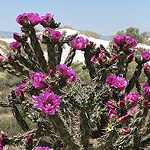
NPS Photo Cane Cholla The cane cholla, often called tree cholla, is the most common species of cholla in New Mexico. It is a tree-like cactus growing to 8 feet tall with spiny, cylindrical, fleshy stems, which when dead show a latticed woody skeleton. The spines are very finely barbed and difficult to remove from flesh. It is often conspicuous because of its shrubby or even tree-like size, its silhouette, and its long-lasting yellowish fruits. This species blooms in late spring or early summer. The flowers are purple or magenta. The fruits are yellowish and shaped something like a cone, with a hollow at the wide end where the flower fell off; they are often mistaken for flowers. The plant retains them all winter. The name "cane cholla" derives from the fact that canes, furniture and other souvenirs are often made from the attractive woody skeleton of dead plants of this species. The thorns can be used for sewing needles or to make improvised fish hooks. Cholla buds are high in calcium. Local native peoples ate the fruit raw, stewed or dried and ground into flour. 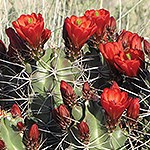
NPS Photo Claret Cup Cactus The claret cup cactus, also known as strawberry hedgehog, is primarily found north of the dunes in the Tularosa Basin. The claret cup cactus blooms in late spring with gorgeous crimson chalice-shaped flowers that give the plant its name. These bright flowers cover large clumps of the cactus, making it easy to spot. The cactus can reach huge sizes with older individual plants growing up to five feet in diameter with more than 75 stems. The fruits of the claret cup cactus are some of the sweetest of any desert plant. The fruits are covered with spines as they develop but shed the spines as the fruit ripens. 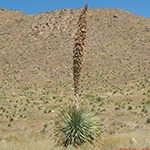
White Sands Missile Range Photo Desert Spoon Also known as sotol or desert candle, the desert spoon gets its name from the spoon-like depression at its leaf base. This perennial evergreen shrub has thousands of tiny greenish-white flowers in a long, narrow cluster that grows from a dense bunch of many slender, spiny leaves. It blooms May – July. The plant’s form is similar to agave, but it does not die after flowering. American Indians and Mexicans prepared an alcoholic drink known as stool, which has a colorless penetrating odor and a peculiar taste, by roasting the flower head in a pit for 24 hours and then distilling the juice. The tough leaves are used to make mats, baskets, ropes, thatch, and paper. The broad, spoon-like base is often used in dried floral arrangements. 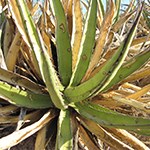
NPS Photo Lechuguilla Lechuguilla is one of the most widespread of the agaves and is the signature plant of the Chihuahuan Desert. Its succulent, yellow-green rosettes are 1-2 feet tall and widely suckering. It blooms May – July. Thick, leathery leaves are tipped with a strong spine and have hooked teeth along the margins. The lechuguilla, like its relative, the century plant, requires 12–15 years to store up enough food for the production of the large flower stalk, which then grows amazingly fast up to 15 feet tall. The stalk is unbranched and flexible, so that it often bends when it is heavy with buds or flowers, retaining a permanent, graceful arc. The upper part of the stalk is covered with a solid mass of purplish or yellowish flowers. After producing flowers and seeds, the stalk dies. Toxic juice from the leaves has been used as arrow poison, a fish stupefier, medicine and soap. Leaf fibers were used for cordage for bow strings, nets, baskets, mats, sandals, blankets, and cloth. Roots pounded and soaked in water were used for soap and shampoo. The leaves of Lechuguilla are so sharp they can cause injury to animals and humans and can even puncture the tires of off-road vehicles. The plant is still harvested in Mexico for its fiber that is made into rope. 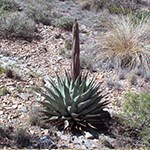
White Sands Missile Range Photo New Mexico Agave New Mexico agave’s stiff, succulent, sword-like leaves with spined tips form a basal rosette 6-18 inches high. Leaves are light green. A 7-10 foot flowering stalk appears after 8-20 years and bears yellowish, tubular flowers in clusters on many lateral branches. New Mexico agave only flowers once in its lifetime (hence the name century plant), after which the original plant dies; but since it suckers freely, new plants will replace it. It is a common misconception that agaves are cacti. They are not related to cacti, nor are they closely related to aloe whose leaves are similar in appearance. All major parts of the agave are edible: the flowers, the leaves, the stalks or basal rosettes, and the sap. Its bruised leaves afforded a paste from which paper was manufactured. Its juice was consumed as a fresh drink or fermented into an intoxicating beverage, pulque. Its leaves supplied an impenetrable thatch for dwellings. Pins and needles were made from the thorns at the extremity of its leaves. The fibers were used for bowstrings, brushes, cradles, nets, slings, shoes, skirts, mats, rope, thread, baskets, and snares. The fresh root was used as soap and shampoo. Early Europeans distilled the juice to make mescal or tequila. 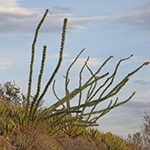
NPS Photo Ocotillo Ocotillo is found in all the deserts of the Southwest. Although this plant looks very much like a cactus due to its long spines and desert habitat, it is not a member of the cactus family. In the spring (April/May) hundreds of brilliant red tubular flowers crowd the ends of the branches, making it an important food source for hummingbirds. After spring or summer rains, the branches burst with leaves; the rest of the year, photosynthesis occurs beneath the grey bark of the stems. It is a very long-lived plant that can live up to 200 years. A fresh bark tincture is the only practical way to prepare ocotillo. The tincture was useful for symptoms that arise due to fluid congestion. Other uses include the relief of fatigue by bathing in water which contains crushed flowers or roots. Many Indian tribes used the flowers and roots of ocotillo to slow bleeding of fresh wounds. Ocotillo is also used to alleviate coughing, achy limbs, varicose veins, and urinary tract infections. Gum resin from the bark was used for waxing leather and as an adhesive/waterproofing agent or varnish. Thorny stems are sometimes placed in the ground to provide living fences. 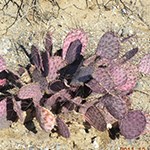
White Sands Missile Range Photo Purple Prickly Pear Cactus The purple prickly pear grows in clumps, usually to about 4 feet tall by 5 feet wide. This cactus appears much like a shrub. The large leaf pads develop a purple tinge in the cool, dry winter months. The pads are covered with large, tan spines. Flowers appear in late spring, and are yellow with red centers and are followed by elliptical fruit to 1.5 inches in length. The rich purple pads provide plenty of interest. During the summer, the pads are a softer blue-grey color. Bright yellow flowers, to 3 inches in diameter, produce red to purple fruit. Unlike many other types of prickly pear, the purple variety has few if any spines. It has a light jasmine scent which is used to attract nocturnal insects. Prickly pear cactus is part of the diet in Mexican and Mexican-American cultures. Only the young plant is eaten; older plants are too tough. Prickly pear cactus is also used for medicine. In foods, the prickly pear juice is used in jellies and candies. Its juice has also been used to strengthen adobe mortar. 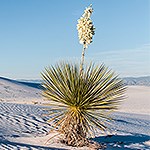
NPS Photo Soaptree Yucca The soaptree yucca uses stem elongation to stay above the advancing dunes. This yucca produces large cream-colored blooms on stalks in late spring. The yucca is a virtual “store” in the desert as American Indians used most parts of the plant. The young flower stalks are rich in vitamin C. The flower pods can be boiled or roasted like a potato. The leaf fibers were used for the fabrication of rope, matting, sandals, baskets, or coarse cloth. The roots were chopped and boiled to produce soap to wash hair, blankets, and rugs. 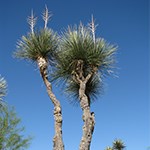
NPS Photo Torrey Yucca The Torrey yucca, a perennial evergreen sometimes reaches a height of 20 feet, but is more commonly 3–10 feet. The trunk is often branched. The flower head may extend to 2 feet on the upper portion of the stem. The flowers are bell-shaped, 2–3 inches long, creamy-white or tinged with purple and bloom from March - May. Leaves are 2 to 4½ feet long, straight and rigid, ending in a sharp spine 1½ to 2 inches long. The leaves radiate around the stem. Great horned owls and roadrunners use this plant as a nesting site. Native Americans ate the pulpy fruits of this and related shrubby species either raw or roasted; they also dried and ground them into meal for winter use. The coarse fibers of the long leaves were made into ropes, mats, sandals, baskets, and cloth. |
Last updated: February 24, 2022
